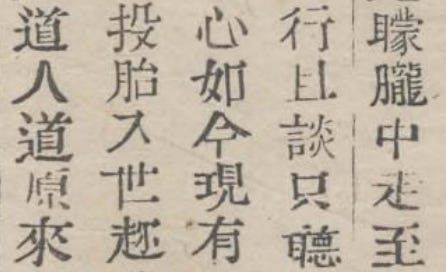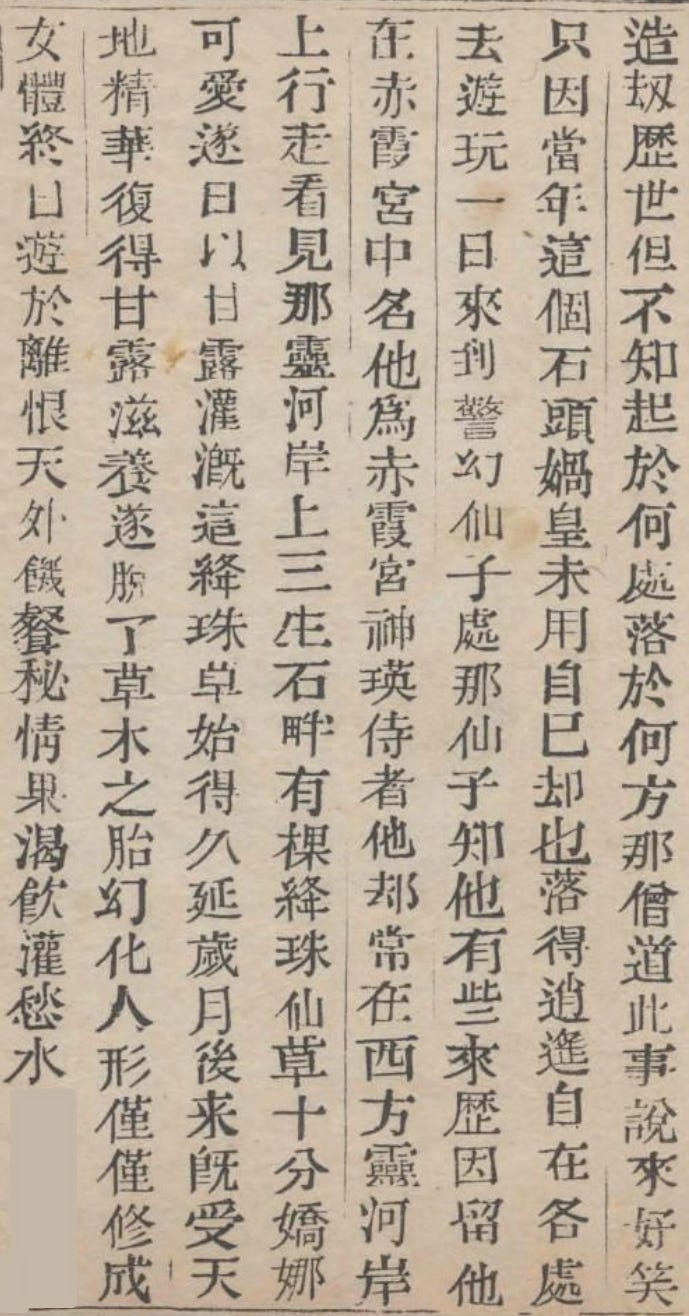Zhen Shiyin's Dream
We pause here for a brief interlude as Zhen Shiyin dreams a strange dream about the same Buddhist monk and Taoist priest. Zhen Shiyin hears them explain the origins of the stone – but this time we learn about a different part of the origin story. We also learn a little bit about the bureaucratic nature of the “celestial realm” that actively shapes the lives of mortals.
While this is a relatively short section of text, there’s a lot of deep stuff to cover here. Hang in there.
Chinese Text
不覺朦朧中走至一處,不辨是何地方,忽見那廂來了一僧一道,且行且談。只聽道人問道:「你攜了此物,意欲何往?」那僧笑道:「你放心。如今現有一段風流公案正該了結,這一干風流冤家尚未投胎入世,趁此機會,就將此物夾帶於中,使他去經歷經歷。」那道人道:「原來近日風流冤家又將造劫歷世。但不知起於何處?落於何方?」那僧道:「此事說來好笑。只因當年這個石頭,媧皇未用,自己卻也落得逍遙自在,各處去遊玩。一日,來到警幻仙子處,那仙子知他有些來歷,因留他在赤霞宮中,名他為赤霞宮神瑛侍者。他卻常在西方靈河岸上行走,看見那靈河岸上三生石畔有棵絳珠仙草,十分嬌娜可愛,遂日以甘露灌溉,這絳珠草始得久延歲月。後來既受天地精華,復得甘露滋養,遂脫了草木之胎,幻化人形,僅僅修成女體,終日遊於『離恨天』外,飢餐『祕情果』,渴飲『灌愁水』。」
Translation Notes
風流公案 is kind of a playful metaphor. 公案 usually refers to legal cases, though in some religious contexts it refers to a paradoxical anecdote meant to provoke enlightenment. 風流, as we’ve seen before, refers to romance. The monk and priest are talking about a legal case, but one that involves love. This gives off the idea of the monk and priest going about on official duty as if they were the employees of some heavenly government. We’ll see more of that cosmic bureaucracy at work.
冤家 refers to a lover here (風流冤家) and not somebody that you hate. This is a bit of a linguistic paradox. Note that 風流冤家 here does not specifically refer to two people; it might be tempting for us to simply conclude that they refer to Jia Baoyu and Lin Daiyu (who we’ll meet later), but that’s simply not part of the original language. “Star-crossed lovers” is an adequate translation, since 冤家 refers specifically to sweethearts that are fated to be together.
造劫歷世 is another paradox. 造劫 is inherently negative: the Buddhist idea behind 劫 (कल्प in Sanskrit, or kalpa) is “disaster.” On the one hand, the lovers (風流冤家) will soon experience the world (歷世); however, on the other hand, disaster is imminent (造劫).
警幻仙子 is traditionally translated as “the Goddess of Disenchantment” in the David Hawkes tradition. 仙子 undoubtedly means “goddess.” However, the word “disenchantment” is an utterly negative English term, and carries with it a connotation that simply does not exist in the Chinese original. 警 refers to “warning” or “awakening,” and 幻 refers to fantasies and illusions. That’s where the idea of “disenchantment” comes from – but this name is almost certainly better seen as “the Goddess of dispelling dreams” or something similar. Remember Cao Xueqin’s stated goal to “省了些壽命筋力,不更去謀虛逐妄了” (“help them save the time and energy they might otherwise spend chasing empty dreams and illusions”) a few posts ago. Here we’ll call her “the Goddess Who Unveils Illusion,” because that’s her actual role. It’s not to disenchant as in to “disappoint” or “to remove a magic spell.” We’re talking about disenchanting as in removing deception — but the Goddess’ role is not just to contradict falsehoods, but, rather, to unveil your eyes and show you the truth.
赤霞宮 literally means the “crimson, misty palace.” The color red here is pretty important. Remember that 紅塵 (“red dust”) refers to the mortal world. By going to the palace, the jade is literally going across the bridge connecting the mystical, divine world (“霞” or mist) and the earthly world (“赤”).
神瑛侍者 is another important concept. 侍者 means servant or attendant. 瑛 (pronounced yīng) is a beautiful piece of jade or jade-like stone. We could call this something like “the divine luminous servant,” but that seems a bit wordy for our purposes. I went with “heavenly jade” as a compromise between readability and literalism. Note here that this name is given to Jia Baoyu by the Goddess Who Unveils Illusion, as if the entire heavenly bureaucracy is telling Jia Baoyu what they expect him to be.
靈河 means the river of spirits; here we’ll simply call it the Sacred River. Its western location (西方) refers to the “western paradise” of the Amitabha Buddha – this is a land of bliss where devotees hope to be reborn. As you can see, the concepts of rebirth, karma, and the purpose of life are intricately woven into all aspects of the first chapter.
三生石 is a pretty deep concept. 三生 can refer to the Buddhist concept of cyclical rebirth – the “three lifetimes.” It’s also derived from an old Tang Dynasty story that exists under 僧圓觀傳 (the biography of Monk Yuanguan) in the 太平廣記. When Yuanguan was about to die, he told his friend Li Yuan that he would meet him near a stone at Tianzhu Temple in Hangzhou – but only after three lifetimes. Li Yuan did visit the stone after three lifetimes, and heard a shepherd boy (actually the reincarnated Yuanguan) sing a poem confirming their reunification. Another poem by Tang poet Bai Juyi refers to this story: “三生石上舊精魂,賞月吟風不要論。慙愧情人遠相訪。此身雖異性長存。” or “An old soul bound to the Stone of Three Fates, no need to speak of moonlit joys and whispered verse. I’m move that you, my love have come so far – this body has changed, but our hearts are the same.” We’ll see later that Bai Juyi’s poetry is very closely intertwined with Cao Xueqin’s composition.
Keep reading with a 7-day free trial
Subscribe to Dream of the Red Chamber to keep reading this post and get 7 days of free access to the full post archives.






